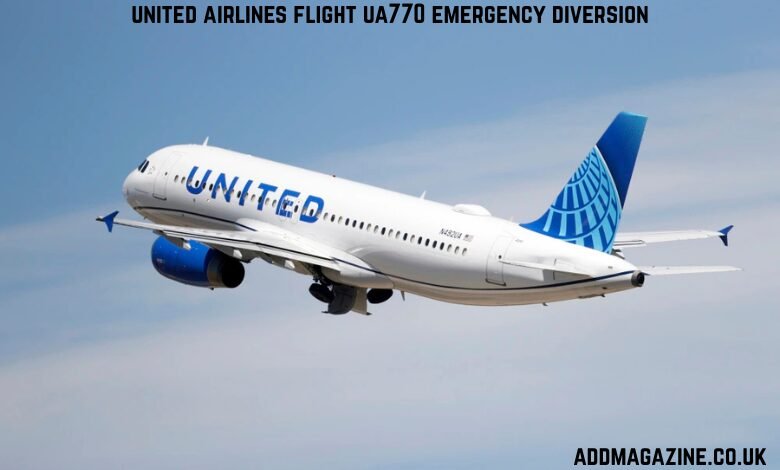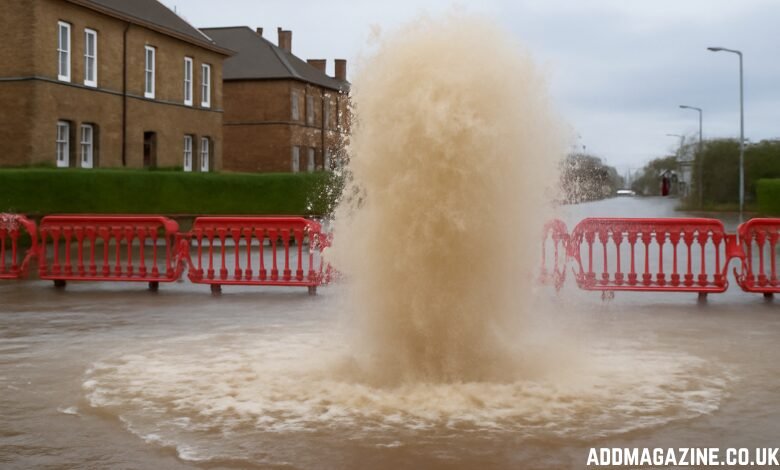United Airlines Flight UA770 was scheduled as a routine long-haul service from Barcelona, Spain, to Chicago, United States. Operated by a Boeing 787-9 Dreamliner, the aircraft took off with 257 passengers and 12 crew members on board. Roughly ninety minutes after departure, an unexpected technical issue led the pilots to declare a general emergency and divert to London Heathrow Airport.
Although the diversion disrupted travel plans for everyone aboard, the incident demonstrated how airline crews, ground teams, and air traffic controllers work together under pressure to prioritize safety.
The Flight’s Planned Journey
Flight UA770 was part of United Airlines’ regular transatlantic schedule. Departing from Barcelona–El Prat Airport in the afternoon, the aircraft’s route took it northwest over the Pyrenees, across France, and toward the Atlantic, where it would begin its oceanic crossing to Chicago O’Hare. The Boeing 787-9 Dreamliner was chosen for its range, fuel efficiency, and passenger comfort features, making it well suited for the roughly nine-hour journey.
The takeoff and initial climb were uneventful. Weather conditions were favorable, visibility was clear, and there was no immediate indication of any operational concerns.
The Onset of the Problem
About one and a half hours into the flight, while cruising at an altitude near 37,000 feet, cockpit indicators alerted the pilots to a possible issue with the aircraft’s pressurization system. In commercial aviation, cabin pressurization is essential; it ensures that passengers and crew can breathe comfortably despite the thin air at cruising altitudes.
Even if the symptoms of the problem were not immediately critical, pressurization warnings are taken seriously. Left unaddressed, such issues could lead to discomfort, oxygen deprivation, or, in rare cases, the need for oxygen mask deployment.
Declaring the Emergency
In response to the alerts, the pilots followed their training protocols. This involved assessing the situation, consulting checklists, and communicating with air traffic control. The crew decided that the safest course of action was to divert to the nearest major airport with the facilities to handle a Boeing 787-9 and to accommodate an unscheduled arrival.
The captain transmitted a squawk code of 7700 via the aircraft’s transponder. This code is universally recognized by air traffic control as a general emergency signal, prompting controllers to give the flight immediate priority in routing and landing clearances.
Choosing London Heathrow
London Heathrow was identified as the most suitable diversion point. It was within a manageable distance from the aircraft’s position over Europe, offered extensive maintenance facilities, and had full emergency response services ready at all times. The airport’s multiple long runways could accommodate a heavy Dreamliner, and its location allowed for rapid descent and landing.
Air traffic control in the UK coordinated with the flight crew to plot the most direct route to Heathrow. Other aircraft in the vicinity were re-routed to clear the way.
Descent and Approach
Once clearance to divert was granted, the pilots began a controlled descent. In cases of suspected pressurization issues, reducing altitude can lessen strain on the aircraft’s environmental control systems and ensure safer conditions for everyone on board.
During the descent, the cabin crew communicated calmly with passengers, explaining that the flight would be landing in London due to a technical problem. Although oxygen masks were not deployed, the reassurance from the crew helped maintain a composed atmosphere in the cabin.
Landing at Heathrow
The Boeing 787-9 touched down at Heathrow in the late afternoon. Emergency vehicles lined the runway as a precaution, ready to respond if needed. The landing itself was smooth, and there were no reports of injuries among passengers or crew.
Once parked at the gate, the aircraft was met by ground staff, engineers, and airline representatives. Passengers were guided into the terminal while maintenance teams began assessing the technical fault.
Immediate Passenger Care
For those onboard, the diversion meant missed connections and disrupted travel plans. United Airlines arranged accommodations for passengers who could not continue their journey the same day. Hotel rooms, meal vouchers, and assistance with rebooking were provided. Customer service teams worked to place passengers on the next available flights to Chicago or their final destinations.
For travelers in unfamiliar surroundings, this logistical support was essential in easing the inconvenience caused by the unscheduled landing.
Technical Assessment
Once passengers were safely inside the terminal, the airline’s engineering team began a thorough inspection of the aircraft. Early indications pointed to a malfunction within the pressurization system, though the exact cause—whether mechanical fault, sensor issue, or system anomaly—would require deeper investigation.
The aircraft remained grounded until repairs could be completed and it was deemed airworthy again. Safety inspections after incidents like this are comprehensive, often involving both the airline’s own engineers and independent aviation safety authorities.
The Role of Crew Training
One of the most notable aspects of the incident was the crew’s handling of the situation. Pilots undergo extensive simulator training for a wide range of potential in-flight emergencies, including pressurization failures. This preparation ensures they can assess a problem quickly, communicate with air traffic control, and decide whether a diversion is necessary.
Cabin crew training is equally critical. Their ability to keep passengers calm and informed can make a significant difference in how the event is experienced by those on board.
Air Traffic Control Coordination
Declaring a general emergency triggers an immediate response from air traffic controllers along the flight’s path. Controllers must quickly coordinate handovers between sectors, ensure the flight has an unobstructed route, and position it for a safe approach. For a large hub like Heathrow, this often involves rearranging arrival sequences and temporarily holding other aircraft.
This seamless coordination between the cockpit and multiple ATC centers—across different countries’ airspace—reflects the highly structured nature of international aviation.
Why Diversions Happen
Emergency diversions are relatively rare, but they are a critical part of aviation safety procedures. Modern commercial aircraft are designed with redundancy, meaning most systems have backups. However, certain types of faults, especially those involving pressurization, structural integrity, or fire warnings, require immediate landing at the nearest suitable airport.
The decision to divert is made based on the principle of minimizing risk, even if the problem could potentially be managed until the scheduled destination. Passenger safety is the overriding factor.
Impact on the Schedule
For United Airlines, an incident like this can disrupt not just one flight but an entire operational chain. Aircraft assigned to one route are often scheduled for other flights shortly afterward. When a diversion occurs, crews may exceed their legal duty limits, requiring substitutions and reshuffling of both aircraft and personnel.
In this case, the grounded Dreamliner in London required the airline to arrange an alternate aircraft for future services, while also rescheduling the continuation of Flight UA770’s journey.
Passenger Experiences
While most passengers experienced only mild inconvenience, accounts from those aboard noted the professionalism of the crew. The announcement from the captain was direct and informative, avoiding unnecessary alarm. Flight attendants continued normal service until preparations for landing began, which helped maintain a sense of normalcy.
For some travelers, the experience served as a reminder of the robustness of aviation safety systems. Even with a mid-air emergency, the outcome was orderly and safe.
Post-Incident Review
After any incident involving a declared emergency, the airline conducts an internal review. This process typically includes:
- Technical Analysis – Identifying the root cause of the fault and verifying the effectiveness of repairs.
- Crew Debriefing – Reviewing the decisions made in real time and identifying any opportunities for procedural improvements.
- Regulatory Reporting – Providing required documentation to aviation authorities in the countries involved.
- Preventive Measures – Adjusting maintenance schedules, inspection routines, or operational procedures if needed.
These reviews aim to learn from the incident and reduce the likelihood of recurrence.
The Bigger Picture: Aviation Safety
Events like the UA770 diversion underline the multi-layered safety net built into modern aviation. From design and maintenance to crew training and air traffic control, each layer functions independently yet supports the others. The fact that the aircraft landed without injury or further complication is not just fortunate—it is the intended outcome of decades of industry-wide safety development.
Key Facts Recap
| Category | Details |
|---|---|
| Flight Number | UA770 |
| Aircraft Type | Boeing 787-9 Dreamliner |
| Origin | Barcelona–El Prat Airport, Spain |
| Destination | Chicago O’Hare International, USA |
| Diversion Airport | London Heathrow, UK |
| Passengers | 257 |
| Crew | 12 |
| Reason for Diversion | Suspected cabin pressurization issue |
| Emergency Declared | Yes – squawk 7700 |
| Injuries | None |
Conclusion
The emergency diversion of United Airlines Flight UA770 was an unplanned interruption to a routine transatlantic journey, but it also served as a clear example of aviation safety systems functioning as intended. The crew’s prompt action, the coordination of multiple air traffic control agencies, and the readiness of ground teams ensured a safe outcome.
For passengers, the event was a reminder that while air travel is one of the safest modes of transportation, crews are trained to respond decisively when something does go wrong. For the airline, it was an operational challenge and an opportunity to review and reinforce existing safety practices.
While the technical cause will ultimately be confirmed through detailed inspection, the most important fact remains: every passenger and crew member arrived safely on the ground, thanks to a professional, coordinated response.




